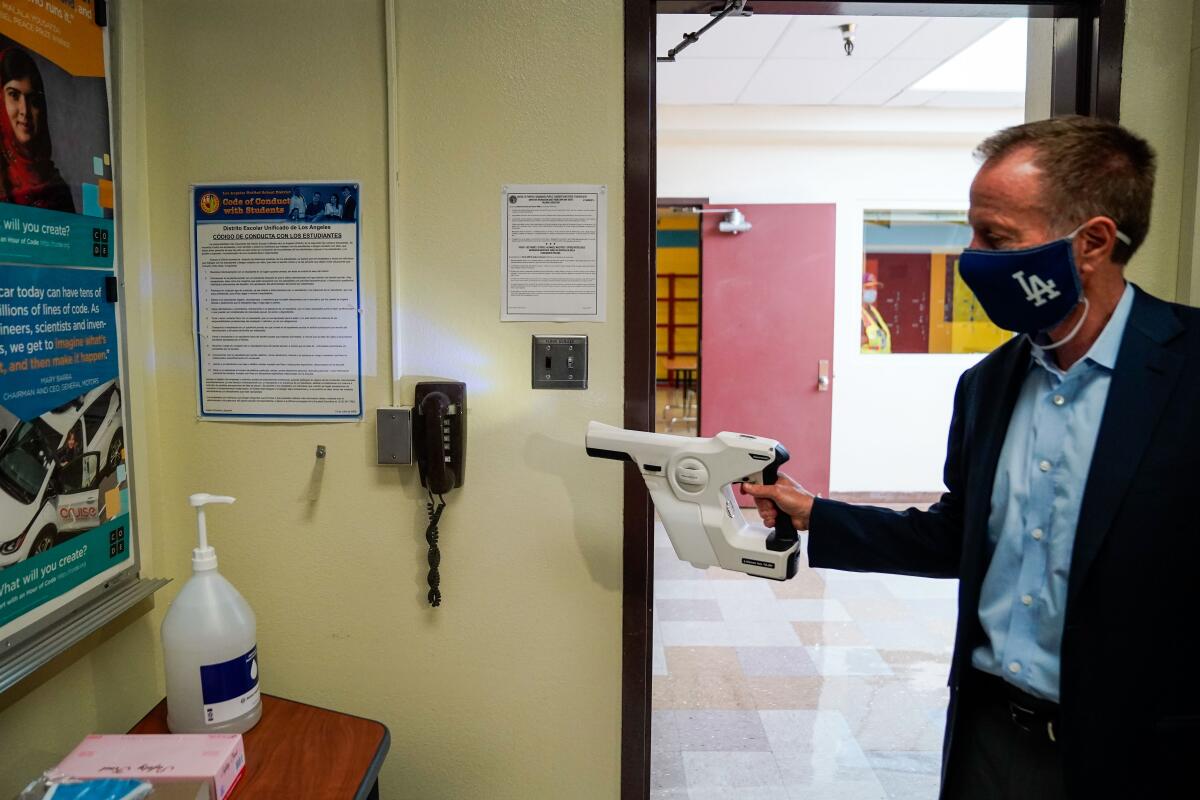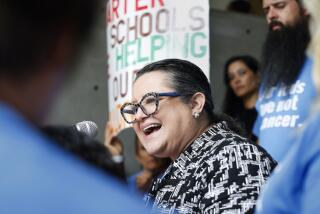L.A. school board approves deal on remote learning; critics say it falls short on teaching

- Share via
With families anxious about the quality of online learning, the Los Angeles Board of Education on Tuesday unanimously approved a plan that will restore structure to the academic schedule while also allowing for an online school day that is shorter than the traditional one.
The plan leaves some parents and advocates in the nation’s second-largest school system wanting more teaching hours. There also are parents who want fewer mandatory screen-time hours for their young children — a reflection of the complexities of distance learning and the widespread parent angst over the start of the school year next week at home, online.
“We’re trying to work through new problems we’ve never had to solve before,” said L.A. schools Supt. Austin Beutner, who praised both his team and the teachers union for working together to preserve high-quality “teacher-led instruction.”
“It is not perfect, but in the midst of a pandemic, perfection has never been a goal,” Beutner said.
Objections to the agreement fell mainly into two categories — the length of the teacher-led school day and lack of parental input. The agreement establishes a school day running on Tuesday through Friday from 9 a.m. to 2:15 p.m., along with an overall teacher work day of six hours. Monday is a shorter day — to allow for teacher planning, a common practice before the pandemic.
Critics said the school schedule runs about two hours too short, depriving students of about 25% of the contact they would normally have with teachers.
“Instructional time, where students can connect with their teacher, is the most valuable resource the district has, but LAUSD is signing away over 7 million instructional hours. This is a bad deal for students, and every board member should vote no,” said Seth Litt, executive director of the local advocacy group Parent Revolution.
A similar to-the-wire drama is playing out in Glendale, Oakland and other school systems across the state — with officials uncertain over when campuses would be able to reopen in some form. The situation clarified for the time being after Gov. Gavin Newsom announced that campuses would have to remain closed in counties that are on the state’s COVID-19 watch list, an emergency order that affected 97% of the state’s K-12 students.
Until then, and for most of the summer, officials were simultaneously planning both for online-only instruction and hybrid instruction, in which groups of students would attend class on campus on a staggered schedule. Officials also were refining protocols on how to sanitize campuses while pulling together needed technology and curriculum.
In many places, maybe most, negotiating with local teacher unions over what learning would look like got pushed to the end.
Teachers in San Francisco did not reach a tentative agreement with district officials until Thursday — several days after L.A. Unified reached its tentative pact. Unlike the L.A. agreement, San Francisco teachers can set their own school-day schedules, within reason, but are asked to keep them as consistent as possible from week to week.
Glendale Unified has yet to reach an agreement with its teachers. Another bargaining session is scheduled for Wednesday. One area of disagreement is over the number of required live interactions per day between students and teachers, according to the union.
The Compton teachers union staged a protest Tuesday over what it called an unsafe district demand for teachers to carry out distance learning from their classrooms. Negotiations also resume there on Wednesday.
L.A. teachers have the option of teaching from their classroom but do not have to do so.
Join us at 1 p.m. August 12 with reporters Howard Blume and Paloma Esquivel to talk about their education reporting during the coronavirus pandemic.
Oakland Unified began the school year this week without a full agreement and just barely hammered out how the first two weeks would unfold as a stopgap. Oakland teachers want to model some of their long-term agreement on what was worked out in L.A.
None of these concurrent challenges were of much solace to critics in L.A. Unified.
“A highly trained, professional, qualified teacher is the most valuable resource the district has,” said Hannah Gravette, of the advocacy group Innovate Public Schools. “To throw away the time available to make use of that resource is the wrong response.”
Maryam Qudrat, a parent at Millikan Middle School in Sherman Oaks, told the board Tuesday that parents should have been allowed to provide input sooner.
“It feels like it’s too late for us to make a difference at this point,” she said.
Parental anxiety comes in various forms. One elementary parent told the Times of concerns at her school that younger students were being required to be glued for too long to a computer monitor.
In the end, board members hardly had the option of rejecting the plan — in whole or in part, which would have led to restarting intense and slow-moving negotiations. L.A. Unified, in fact, has already publicized and built its restart around this agreement.
The plan’s schedule includes daily live contact with a teacher and specifies that the state’s existing minimum requirements for instructional minutes in a traditional classroom also will apply to online teaching.
Also at Tuesday’s meeting, the board approved sweeping new regulations that will make it more difficult for new charter schools to win approval. The rules also could threaten the renewal of existing charters that were never previously at risk of being shut down.
Charters are privately managed public schools that must be authorized by a public education entity. L.A. Unified has more charters than any other school system, where they enroll about one in five students.
On balance, charter-school supporters strongly oppose the new regulations.
The school board is closely divided between members elected with substantial support from charter advocates and those elected with substantial support from the teachers union.
The 4-to-3 vote on the new rules underscores the importance of the upcoming November school board elections, which will determine whether the state’s largest district will become more or less friendly to charter schools.
More to Read
Sign up for Essential California
The most important California stories and recommendations in your inbox every morning.
You may occasionally receive promotional content from the Los Angeles Times.















